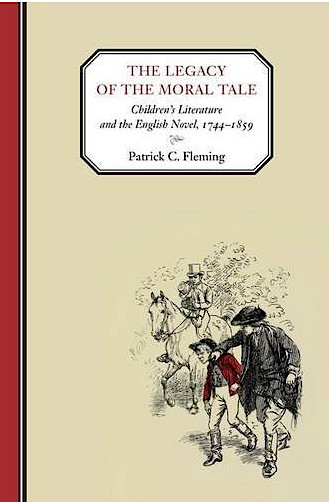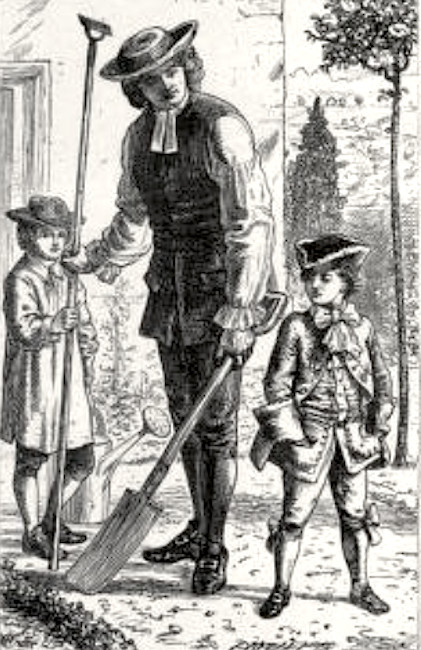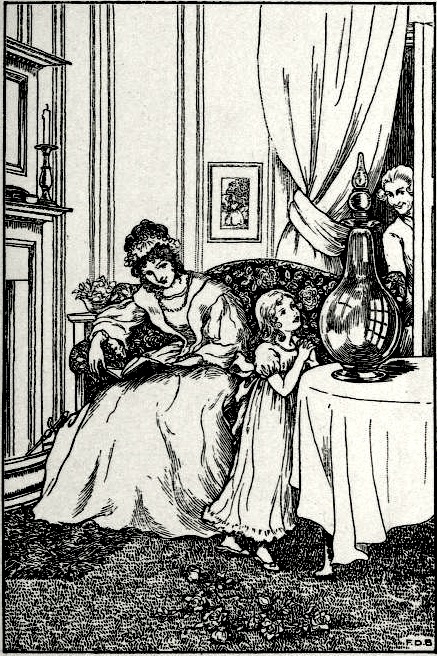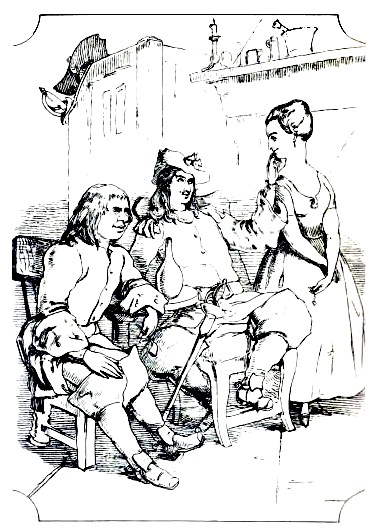This review is reproduced here by kind permission of the online inter-disciplinary journal Cercles, where it is also being published. The original text has been formatted and illustrated for the Victorian Web by the author. Click on the images for larger pictures and sometimes for full bibliographic information and commentaries.



Left to right: (a) Cover of the book under review. (b) "The first day at Mr Barlow's": Tommy Merton disdains manual labour, and so has to forgo its rewards. Source: Day, facing p. 9. (c) "In a moment it was on the table. Rosamond ran up to it with an excalation of joy." But she has made the wrong choice by demanding the useless jar instead of serviceable footwear! Source: Edgeworth, "The Purple Jar," 67.
Modern sensibilities are outraged when early children's authors like Mrs Sherwood dole out cruel and unusual punishments to recalcitrant child characters. The best-known example is that of young Augusta Noble in The Fairchild Family (1814-47), who burns to death after defying her mother and playing with candles. But there were, even then, gentler ways of attempting to instil obedience into young readers. Unlike the penny tracts and later Evangelical writings, or those of the Tractarian Charlotte Yonge, the moral tale directed children's attention to the consequences of their actions in this world rather than the next, and did not consign their small protagonists to either painful or "holy" deaths on the way. Punishments ranged from being denied a share of cherries, as Tommy Merton is in Thomas Day's Sandford and Merton (1783), to having to go poorly shod for a month, like Rosamond in Maria Edgeworth's "The Purple Jar" (1796). Fleming has set himself the useful task of rehabilitating this genre by pointing out how thoroughly such tales permeated not only later children's fiction (including the fantasies of the apparently liberating "golden age" of the later period) but the great adult novels of the Victorian era as well.
This is not something that earlier critics have entirely overlooked. To give just a couple of examples, both from the beginning of this century, Laura Peters calls Oliver Twist itself a moral tale (40), and Bernard J. Paris describes Silas Marner (not discussed at all by Fleming), as "George Eliot's most simplistic moral tale" (173). There is general agreement too that both Lewis Carroll and Charles Kingsley were not just reacting against the moral tale, but capitalising on it in various ways, and were, besides, pushing their own agendas — and this is something that Fleming himself does acknowledge. What is new and refreshing here, however, is Fleming's close attention to and appreciation of the narrative form of the moral tale, and to the kind of reading it demanded, something that developed productively over time. This in turn affected what later authors took from this large body of writing.
Despite the juxtaposition and interaction of what he terms "mimetic and emetic characters"(13) in Sandford and Merton, for instance, Fleming feels that Day simply explains the moral lessons to the young reader. But, he argues, in Maria Edgeworth's work there is no single prescriptive voice: with a more sophisticated narrative structure which invites different, contradictory readings, the moral tale comes of age. Young readers are more deeply engaged, and have to apply their minds to the situations and find their own meanings in them, in other words, they have learn from experience along with the protagonist. In this way, Fleming suggests, Edgeworth overcomes the objection that Rousseau voices in Emile, that "The child who reads does not think, he only reads" (qtd., p.80).
This is useful in two ways. As for Edgeworth herself, her achievements, like those of many other women writers not previously given their due, are more fully recognised now. Fleming is not the first to reveal the greater complexity in her work. But by demonstrating how she developed the moral tale, he is able to strengthen the case for her artistic as well as her historic importance. Then, by stressing the way she encourages "sympathetic, interpretive reading practices" (95), he is able to explain her influence, first on the novels of the Romantic period, and then on the Newgate novels that were so avidly read in the 1830s, and used similar strategies to engage and educate their readers.



Left to right: (a) "Clarence, you have a right to Belinda's hand." All the main characters reap the rewards of virtue here — happiness! Source: Edgeworth. Belinda, 484. (b) "Paul Clifford escorting Lucy Brandon to her Home." The debonair highwayman will win Lucy and they will escape to a new life in America. Source: Bulwer-Lytton, following p. 126. (c) Not horrible enough: "Mrs Catherine's Temptation." Source: Thackeray, facing p.9. /p>
In looking at the former, Fleming focuses on Edgeworth's own "moral tale for adults," Belinda (1802), although there are some helpfully close readings of other novels. A paragraph on Persuasion, for instance, begins rather unpromisingly with a typical and rather clunky thesis "signpost": "Connecting the moral tale and the novel reveals Edgeworth's influence in the form of didacticism" (94). But Fleming then teases out the different, indeed conflicting, moral lessons that Jane Austen suggests through it. There is, after all, a new order of subtlety here. Subjected to similar scrutiny in this context, the Newgate novels too are shown to have drawn on the moral tale's conventions without being bound by them. For instance, Fleming notes that Bulwer-Lytton takes a behaviourist approach in Paul Clifford, demonstrating that Paul is made immoral by the immoral society in which he has grown up. As a result, the novelist is able to question society's legal right to judge him for his crimes as a highwayman. Thackeray's Catherine takes this questioning of the moral tale, and indeed conventional morality, to its furthest point. Fleming argues that Thackeray set out to make the work so completely "emetic" — by, for example, promising readers a murder much more horrible than Nancy's in Oliver Twist — that it would discredit the whole genre. But human nature being what it is, the ploy backfired. Readers and author alike were unable to resist finding the eponymous protagonist/villainess interesting, and even sympathetic. For the time being, at least, the moral tale continued to appeal.



Left to right: (a) The villainous James Carker on his flight through France to confront Mr Dombey. (b) Kyd's version of Uriah Heep, "the 'umblest person going." (c) Daniel Peggotty comes to call on David and his family, presided over by the saintly Agnes. [Click on these pictures for more information].
Having admitted that Catherine is "probably Thackeray's least important novel" (132), Fleming now ventures into more celebrated and fully explored territory. In his next chapter, the focus is on Dickens. Once again his approach is useful: Dickens was certainly familiar with the moral tale, and there is much to be said for looking at not only Oliver Twist, but the Christmas stories, David Copperfield, Dombey and Son, Hard Times and Great Expectations in this context. The polemical Hard Times is probably the most susceptible to Fleming's approach, with Sissy Jupe standing out as "the model the reader should emulate" (160). But by now Fleming's determined adherence to his thesis begins to make rather too familiar a pattern: the point of his discussion of James Carker in Dombey and Son, and Uriah Heep and Agnes in David Copperfield, for example, is to show that Carker and Heep are "emetic" characters, and Agnes a "mimetic" one (151-57), while the point of the chapter as a whole is to demonstrate that Dickens gradually moved away from the moral tale as exemplified by Sandford and Merton, and developed his own "method of experiential didacticism, a method similar to Edgeworth's" (15). This is one way of (re-)considering these familiar novels, but, in general, this kind of schematising seems too narrow and restrictive for works crowded with unforgettable figures and bursting at the seams with creative energy.
To do Fleming justice, he does point out anomalies. Bounderby in Hard Times, for example, is both "emetic" and "moralizing," raising the reader's suspicions about moral instruction. In fact, as Fleming says, the moral tale was now losing its potency. The last and least substantial chapter here is entitled "1859 and After," and it reveals how Thackeray's mission to discredit the moral tale in Catherine was gradually accomplished. 1859 was the year in which George Meredith's The Ordeal of Richard Feverel was published. It is a novel that provides rich pickings for a critic interested in questions of education and learning from experience; it is also one that forcefully demonstrates that no system which purports to prepare a child for the myriad moral challenges of adult life really works — let alone a rigid one. Carroll and Kingsley would also both exploit and subvert the moral tale, as a new kind of children's literature emerged, taking its cue from a variety of sources, ranging from fantasy to evolutionary theory to psychology. Both author and reader faced a much more complex world, one in which a conventionally moralising strain, if not exactly lost, is overlaid by many new considerations.
Numerous citations make Fleming's chapters dense as well as somewhat repetitive. Nearly everyone seems to be brought in, from Edmund Wilson to Foucault, and beyond. However, when it is possible to discern the author's own voice, especially in the insights that accrue from his central message, it is well worth our attention. Fleming has restored to prominence a once popular and later slighted genre, and helped to open up new avenues into some of our best-loved novels. His book may well prove to be the definitive work in this area.
Related Material
Bibliography
[Book under review] Fleming, Patrick C. The Legacy of the Moral Tale: Children's Literature and the English Novel, 1744-1859. Knoxville: The University of Tennessee Press, 2016. Hardback. ix + 24 pp. ISBN 9-781621-902041. £41.01
Paris, Bernard J. Rereading George Eliot: Changing Responses to Her Experiments in Life. Albany: State University of New York Press, 2003.
Peters, Laura. Orphan Texts: Victorian Orphans, Culture and Empire. Manchester and New York: Manchester University Press, 2000.
Illustration Sources
Bulwer Lytton, Edward Paul Clifford. Drawings by W. L. Taylor, etched by W. H. W. Bicknell.Boston: D. Estes & Co., 1898. Internet Archive. Contributed by the Library of Congress. Web. 20 February 2017.
Day, Thomas. The History of Sandford and Merton. Illustrations by Walter Crane, engraved by the Dalziels. London: Frederick Warne, c. 1890. Internet Archive. Contributed by the University of California Libraries. Web. 20 February 2017.
Edgeworth, Maria. Belinda. Illustrated by Chris Hammond. London: Macmillan, 1896. Internet Archive. From the collections of an unknown library. Web. 20 February 2017.
_____. "The Purple Vase." In Old-fashioned Tales, ed. E. V. Lucas, illustrator F. D. Bedford. London: Wells, Gardner, Denton, 1905. 60-69. Internet Archive. Contributed by the University of California Libraries. Web. 20 February 2017.
Thackeray, William Makepeace. Catherine: A Story; Little Travels; The Fitz-Boodle Papers, etc.. London: Smith, Elder,1869. Internet Archive. Contributed by the New York Public Library. Web. 20 February 2017.
Created 20 February 2017